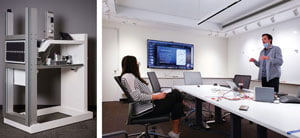 Exploring new architectural innovations to turn wasted energy into reusable electricity
Exploring new architectural innovations to turn wasted energy into reusable electricity
By: Zenon Radewych, Principal, WZMH Architects
The earth is heating up at an unprecedented rate – in fact, according to NASA, 2016 and 2020 are the warmest years on record to date. That’s why now, more than ever, is the time to be creative and look for opportunities to reduce greenhouse gasses. One of these creative opportunities lies in turning the ‘wasted’ energy in our buildings into reusable electricity.
It’s no secret that many of the buildings we live, work, and play in are major polluters. Buildings and their associated construction make up 36 percent of global energy use, and 39 percent of energy-related carbon dioxide emissions annually (The United Nations Environment Program). Here in Canada, our buildings account for nearly one-quarter of our GHG emissions (Environment and Climate Change Canada).
But buildings, largely due to the volume of human and machine activity that goes on within them, also represent a unique domain for energy harvesting from non-traditional sources. At the highest level, we consider three main energy resources in our buildings: people, environmental, and recyclable energy. The environment can of course provide wind, solar and geothermal energy. People bring kinetic and thermal energy, and recyclable sources include artificial lighting, waste heat, machinery vibrations, elevator regeneration, among others.
Our buildings also contain a vast number of components and systems that are DC (low-voltage) based. For example, most of our modern electronics (including computers, phones, lighting and fans) are inherently DC powered and most of the lights in buildings are LED (low-voltage).
Coincidentally, many components of a renewable energy system (such as batteries and solar PV) are also DC-based. But traditionally, we have used the AC grid in our buildings to integrate these DC sources and power DC loads. This results in conversion losses of approximately 10-20% – and can lead to a variety of other complications at the energy grid level.
Exploring the concept of a DC-Microgrid community
At WZMH Architects, we believe that we need to be investing the time, funding and talent to discover new insights about how we design buildings that drive towards net-zero energy use and are carbon neutral. One of our first initiatives included research into off-site construction (prefabrication and modular) and how to combine multiple building systems into one component thereby reducing materials, waste and expediting construction installation.
The result from this research was our invention of the Intelligent Structural Panel (ISP) – a modular structural floor slab that includes a DC (low-voltage) highway imbedded in the thickness of the panel. Since the development of the ISP, WZMH Architects formally launched our Innovation Lab several years ago.
One of our latest studies, conducted in partnership with Ryerson University, includes the use of a community-based DC microgrid, where multiple buildings are all connected through the grid – including residential, commercial (office), retail, data centres, etc. By combining different types of buildings into the DC microgrid community, there are many benefits from the opportunities that relate to recycled energy, or harnessing energy losses.
So, what exactly is a microgrid? A microgrid can be broadly defined as a localized network of electric loads and power sources, with the ability to function independently or in conjunction with a larger grid system. In our context, a DC microgrid represents an alternative power system in a building, where we can power our equipment with various ‘Green Energy Producers’ (GEP), including solar, wind, and even innovative sources like exercise bikes, elevators and use of thermoelectric generators.
SUBSCRIBE TO THE DIGITAL OR PRINT ISSUE OF SABMAGAZINE FOR THE FULL VERSION OF THIS ARTICLE.


